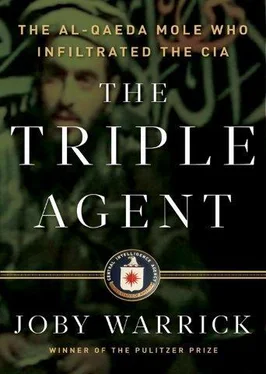Matthews had quickly come to appreciate the extraordinary assets that the base brought to the hunt. Foremost among them were the Counterterrorism Pursuit Teams, a new force of CIA-funded Afghan commandos trained by the SAD. There were three thousand of these soldiers in the eastern half of Afghanistan, a mix of Pakistani- and Afghan-born ethnic Pashtuns who could slip across the border in local costume to kill or capture suspected terrorists or collect information. The intelligence they gathered was shared with the base’s contingent of American case officers and funneled, along with the usual phone and Internet chatter, into the CIA’s giant databases, to be teased and sifted by targeters—Elizabeth Hanson and others like her. Active leads about specific terrorists could be quickly transformed into hard geographic coordinates for the CIA’s growing fleet of Predators.
After eight years of practice, the cogs and wheels turned smoothly most of the time. And lately the men and women in charge of the CIA’s complex machine had seen new evidence of progress. After more than a year of relentless missile strikes, al-Qaeda’s leadership in Afghanistan appeared to be in complete disarray, an assessment based on intercepted conversations between the group’s demoralized operatives. Bin Laden had gone so deeply into hiding that he was effectively absent. Though Zawahiri still guided strategy, command of day-to-day operations had fallen to a handful of lieutenants, chiefly the man known as Sheikh Saeed al-Masri, the Egyptian who had filled the void after the death of Osama al-Kini. But CIA intercepts showed that al-Masri was a highly unpopular leader, tyrannical, manipulative, and controlling. Al-Qaeda fighters whose conversations were monitored complained bitterly about the group’s presumed acting leader.
And the best news of all had come not from Pakistan but from Amman. The Jordanian intelligence service had recruited a star informant who had been dropped into the tribal region with CIA help. The new agent, a Jordanian, had disappeared for several months but had just resurfaced with breathtaking new information. In the course of a few months he had somehow managed to penetrate first the Pakistani Taliban and then, by all accounts, al-Qaeda itself. At senior staff meetings back in Langley, top CIA managers were now speaking in hushed tones about a “golden source.”
A golden source , operating just across the hills in Pakistan, perhaps fifty miles from the small office where Jennifer Matthews now sat. She skimmed the daily cables and waited with increasing anticipation to see what would happen next.
Langley, Virginia—September–October 2009
See attached .
Humam al-Balawi’s first big score as a spy, the one that would surely cement his reputation as the decade’s greatest, arrived at CIA headquarters on a late August morning as a jumble of computer code attached to an e-mail. The agency’s data forensics specialists had been warned, and they set upon it like an army of sushi chefs. They sliced and filleted, separating larger chunks of data into bits and bytes and then reassembling them again.
Several days of scrutiny later the agency’s initial impression stood: The file was authentic. And it was nothing short of miraculous.
Nearly a month after Mehsud’s death, Balawi had seemed to vanish from the earth. There had been no e-mail, phone call, or even intercepted Taliban transmission to explain what had happened to him. Then he suddenly resurfaced in late summer in a short message to bin Zeid. He was back, and he had a gift, he wrote, one that bin Zeid would find to be worth the wait.
The gift was a small image file, a few seconds of low-quality video taken by a handheld camera, the type that can be purchased at any electronics store for a few hundred dollars. The video depicted a small gathering of men in traditional Pashtun dress talking in a dimly lit room. In the foreground was a young man, seen mostly in silhouette, until a sideways turn clearly revealed him to be Balawi. Seated near him was a slim, dark-bearded man in his early forties who was doing most of the talking. His face was instantly recognizable to the agency’s counterterrorism experts, even though no American officer had seen the man in eight years. His name was Atiyah Adb al-Rahman, and he was one of the closest associates of al-Qaeda leader Osama bin Laden known to be alive.
Al-Rahman, a Libyan and an Islamic scholar, had been a top aide to bin Laden since the 1980s, and the two had escaped together into Pakistan after the Tora Bora debacle in late 2001. Afterward he was believed to have fled to Iran, but he emerged again in 2006 as one of al-Qaeda’s top strategic thinkers and spiritual advisers. It was al-Rahman who had tried unsuccessfully to rein in Abu Musab al-Zarqawi, the leader of al-Qaeda in Iraq, when his sadistic attacks against Shia Muslims began to shift the tide of Iraqi public opinion against al-Qaeda. There had been no confirmed sightings of al-Rahman in years; yet here he was, holding forth on video, with a CIA informant seated at his feet.
The images left jaws agape and unleashed a torrent of questions. Yet this much was undeniably true: The Jordanian physician Humam al-Balawi had been in the same room with one of al-Qaeda’s top commanders. He had managed to capture the encounter on videotape. And he had delivered the evidence to the very doorstep of the CIA.
In the eight years since the start of the war against al-Qaeda, no one had ever gotten so close.
Three times a week Leon Panetta opened his seventh-floor office for a gathering of the CIA’s top counterterrorism officials. His deputy, Steve Kappes, attended, along with the directors of the agency’s National Clandestine Service and Counterterrorism Center and a phalanx of aides and briefers. Squeezed around Panetta’s mahogany table, beneath the tattered American flag that had once flown above the World Trade Center, they sipped coffee from china cups and discussed the latest events in Pakistan. One afternoon in early September, the group gathered to pore over an extraordinary transmission from an obscure agent known as Wolf.
There were still photos and a blow-by-blow description of a video—at the time, still undergoing evaluation by technical teams—that showed a presumed CIA informant conversing with one of al-Qaeda’s senior advisers. The agency’s senior managers were bursting with questions. Where did the agent come from? How did he get such amazing access? No one was yet sure what to make of it, except that it was extraordinarily good news.
Two snippets of information about Balawi were particularly intriguing to Panetta. One was the fact that the informant had managed to get his nose under al-Qaeda’s tent with such speed. The time frames for running agents in this region are always very long, the CIA director thought. This one is going from asset to target incredibly fast.
The other surprise was how little the agency seemed to know about the operative in the video.
“Nobody from the CIA has really had any person-to-person contact with him,” Panetta marveled.
There were plausible explanations for all of it. The informant was one of the Mukhabarat’s recruits, and he was already in Pakistan before any American officers could take a look at him. As for his access, it was simple: Balawi was a doctor. Al-Qaeda desperately needed doctors.
Balawi was talented, no doubt. Exactly how good was something the agency needed to find out, and with all possible speed.
“You have lifted our heads,” Ali bin Zeid wrote to Balawi one morning in one of his regular missives from Amman. “You have lifted our heads in front of the Americans.”
Читать дальше












